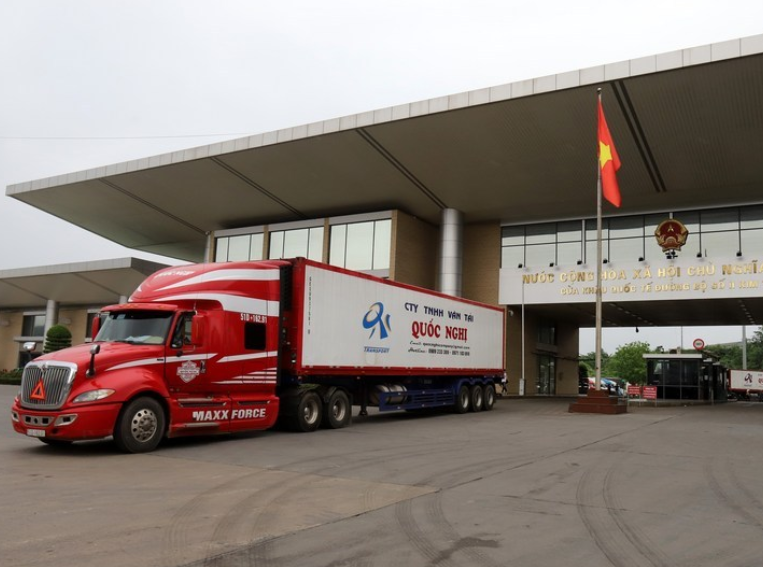NANNING/BANGKOK, Jan. 28 (Xinhua) -- Hundreds of flat-bed and container trucks were waiting in line in a logistics center at Pingxiang, a Chinese city bordering Vietnam, waiting for customs clearance -- a scene signifying the vitality of trade between China and the Association of Southeast Asian Nations (ASEAN) members.
"Our logistics facilities have been overloaded due to peak season ahead of the Spring Festival," said Nong Chaoyong, head of the administration committee of Pingxiang national pilot zone for development and opening-up.
Once they have passed the customs checkpoints, goods from Southeast Asian countries will soon hit the shelves in cities like Beijing and Shanghai, adding to the already impressive momentum of China-ASEAN trade.
In 2020, China and ASEAN for the first time became each other's largest partners, with bilateral trade up nearly 7 percent, defying the gloomy picture of a pandemic-blighted world.
INTERCONNECTIVITY
Infrastructure connectivity makes Pingxiang in south China's Guangxi Zhuang Autonomous Region a gateway to Southeast Asian countries.
The Pingxiang railway port, which connects the railways of China and Vietnam, has seen freight trains go full steam ahead.
Since its launch in 2017, the China-Vietnam freight train service has transported electronics, diesel engines, glass, cotton yarn and other goods from China to ASEAN countries via Vietnam, while goods from ASEAN countries including fruits and daily necessities have been shipped to China.
As a major land port for fruit trade, Pingxiang serves as the entry point for nearly half of the imported fruits into China.
On Feb. 25, 2020, the first China-Vietnam freight train for fruits was launched, connecting Pingxiang with Dong Dang in northern Vietnam, making fruit transportation easier and less costly.
The city has seen the number of cross-border freight trains surge to 251 last year, with that of inbound fruit trains up to 68, said Jiang Jing, head of the Pingxiang railway station.
Two-way trade between China and Vietnam climbed 18.8 percent last year, with exports to Vietnam rising 16.6 percent, while imports surged 22.2 percent on the previous year.
Their geographical proximity gives China and Southeast Asian countries a natural advantage in trade, while better infrastructure connectivity has further boosted the efficiency of logistics, lowered transportation costs and enhanced regional integration, said Cao Xiaoyang, a researcher with the National Institute of International Strategy, Chinese Academy of Social Sciences.
Construction of major infrastructure projects in the region has picked up again after short-term headwinds from the COVID-19 pandemic.
The Kunming-Vientiane railway linking China's southwest Yunnan Province with Laos, slated to open by the end of this year, will allow trains to travel between the two cities in one day. Other major projects, including the China-Thailand railway, Jakarta-Bandung high-speed railway and the Kyaukpyu deep sea port, are also making headway.
INTEGRATION
With COVID-19 threatening to reverse decades of progress in open borders for trade and investment, China and ASEAN countries are ready for advancing cooperation and integration, helping economies in the region to recover.
Since the implementation of the China-ASEAN Free Trade Agreement (CAFTA) in 2010, the trade in goods and services between the two sides has grown rapidly through the integration of industrial and value chains. Tariffs on 7,000 products have been scrapped under the CAFTA framework.
The share of China-ASEAN trade accounted for about 14.7 percent of China's total foreign trade volume in 2020, up from 14 percent in 2019, according to data from China's General Administration of Customs.
The expansion was partly buoyed by growing farm produce trade with ASEAN members under the upgraded protocol of the CAFTA, which came into effect in October 2019.
The upgraded CAFTA protocol has enhanced bilateral cooperation, while the Regional Comprehensive Economic Partnership (RCEP) will further intensify regional economic integration, said Bai Ming, a researcher from a research institute affiliated with China's Ministry of Commerce.
The RCEP brings together 15 Asia-Pacific countries, which together account for almost 30 percent of the world's population and cover about 30 percent of the world's real gross domestic product (GDP).
By creating common rules in trade and investment, the RCEP will enable enterprises to configure their supply chains more efficiently, said Yuan Bo, a researcher with the Chinese Academy of International Trade and Economic Cooperation.
China and ASEAN's expanding cooperation in emerging sectors such as 5G, artificial intelligence, e-commerce and cross-border logistics will further boost trade and investment in the region, analysts said.
IRREPLACEABLE MARKET
"Despite COVID-19, our export to China is really good," said Narongsak Chuensuchon, chairman of NC Coconut, a company in Thailand's Ratchaburi Province.
Narongsak breathed a sigh of relief after China's economic activity resumed after the COVID-19 shock last March. "We produce nearly 100,000 coconut products every day, up to 70 percent of them are exported to China."
"More Chinese consumers turn to online shopping for our products amid the COVID-19 lockdown, lifting our sales," he said. Tapping into China's booming e-commerce market, NC Coconut has teamed up with major online retailers such as Hema Fresh.
"China has a huge market with great potential. Its continuous market opening-up provides more opportunities for both my company and my Chinese partners," he said, adding they are planning to export more product varieties to the Chinese market this year. Enditem




 A single purchase
A single purchase









